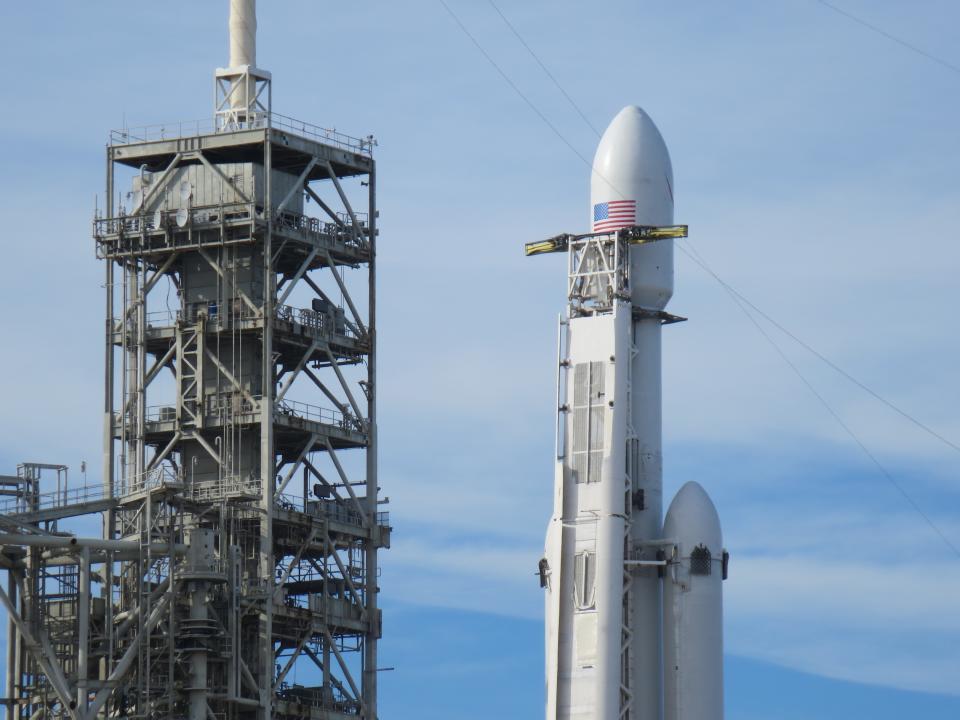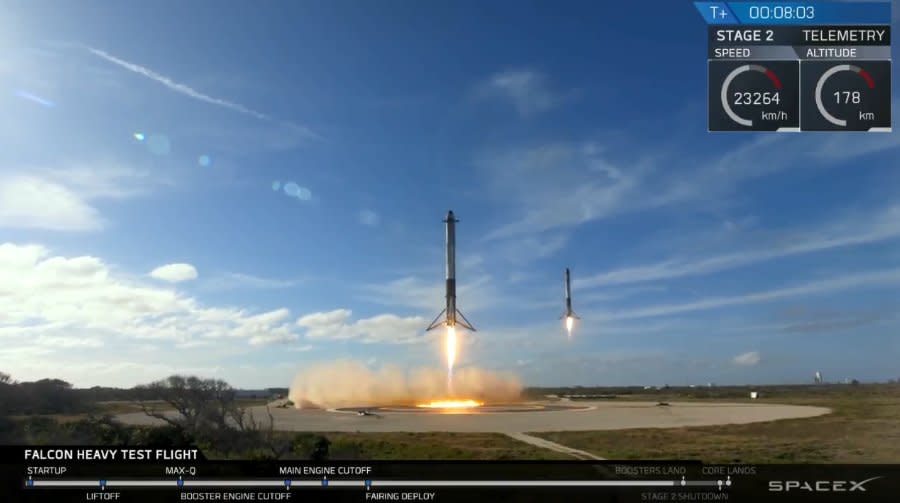SpaceX successfully launches the world's most powerful rocket
KENNEDY SPACE CENTER — Earth has one less sports car.
SpaceX’s Falcon Heavy rocket lifted off at 3:45 p.m., inaugurating itself as the most powerful launch vehicle in service and sending founder Elon Musk’s Tesla (TSLA) Roadster towards a one-way ride out of Earth orbit.
The 230-foot-tall rocket launched at Launch Complex 39A here after a series of delays caused by high winds aloft. As the countdown neared zero and its 27 first-stage engines lit in sequence, clouds of smoke shot out from one side of the pad as the Falcon Heavy and its triple first-stage boosters first eased off the pad and then sprinted into the skies, trailing a blinding jet of fire.

Seconds later, the sound of 5 million pounds of thrust arrived–an avalanche of noise that raced across the water in front of the press site and rushed over journalists as a crackling thunder.

Some seven minutes later, the Falcon Heavy’s two outer first-stage boosters–both flown before in 2016 as Falcon 9 first stages–reappeared in the skies as two bright dots as they performed a powered descent to land on pads constructed at Cape Canaveral Air Force Station.
Their sonic booms–thunderclaps that sounded like fireworks going off far too close for safety–punched through the air about a minute later.
The Falcon Heavy’s inner booster was intended to fly itself to a touchdown on the autonomous drone ship Of Course I Still Love You that hosted SpaceX’s first successful first-stage landing. But the company had not announced the fate of that stage by half an hour after launch.
In its successful flight to orbit, the Falcon Heavy vindicated the not-quite-confident confidence of Musk. At a teleconference Monday afternoon, he had described himself as at ease but then fretted about such possibilities as the three boosters coming apart in flight or the entire stack not surviving “max-Q,” peak aerodynamic pressure.

Just in case, the commercial space transportation license issued by the Federal Aviation Administration last week required SpaceX to carry $294 million in liability and property insurance.
The successful launch also quieted concerns among some space observers over the Falcon Heavy’s complexity–nine Merlin engines in each of its three first-stage boosters–who recalled the Soviet Union’s N1 ill-fated moon rocket.
That massive vehicle, with a full 30 engines in its first stage, blew up on all four of its launches between 1969 and 1972. The second such explosion in July 1969 began less than a second after liftoff and leveled the pad at Baikonur Cosmodrome.
This launch matters for more than bragging rights. With a successful launch of the privately-built Falcon Heavy, SpaceX has now broken a governmental monopoly on orbital flight on every level except those involving human passengers.
And SpaceX aims to pass that line late this year or early next year, when it launches a Falcon 9 with a crewed Dragon capsule on top. That should lead to a series of flights under a NASA contract to transport astronauts to and from the International Space Station so it can stop relying on Russian Soyuz rockets and capsules.
But SpaceX isn’t alone in that contest or even in the race to field the most powerful rockets on Earth. Boeing (BA) also has a NASA contract for crew transport to the ISS–it’s rented one of the buildings here used to refurbish space shuttles to build its CST-100 Starliner capsule.
And anybody who drove up to KSC from due south could not have missed the giant Blue Origin rocket factory now open just west of the space center.
The space-launch firm founded by Amazon (AMZN) CEO Jeff Bezos will use that facility to construct its New Glenn rocket–a launch vehicle with a reusable first stage and the ability to lift almost 50 tons to low Earth orbit and 14 tons to geosynchronous orbit. A three-stage version will be able to loft considerably more payload.
In this new space race, profits and losses are on the line as well as national pride.
More from Rob:
Email Rob at [email protected]; follow him on Twitter at @robpegoraro.
Follow Yahoo Finance on Facebook, Twitter, Instagram, and LinkedIn
